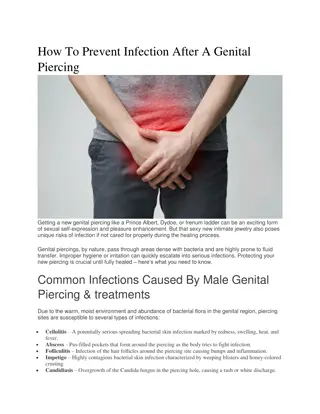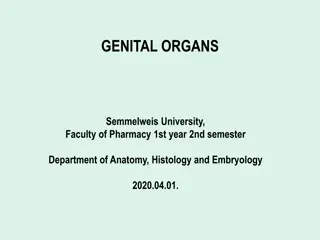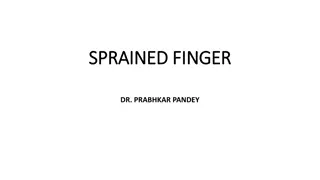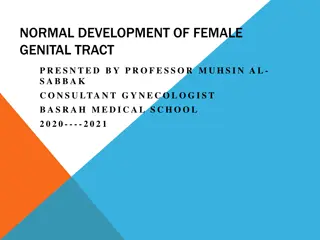Genital Fistulas - Causes, Symptoms, and Treatment
Genital fistula, an abnormal connection between genital and urinary or GI tract, affects millions of women worldwide. Learn about its types, causes, prevention, and treatment to improve maternal health outcomes.
Download Presentation

Please find below an Image/Link to download the presentation.
The content on the website is provided AS IS for your information and personal use only. It may not be sold, licensed, or shared on other websites without obtaining consent from the author.If you encounter any issues during the download, it is possible that the publisher has removed the file from their server.
You are allowed to download the files provided on this website for personal or commercial use, subject to the condition that they are used lawfully. All files are the property of their respective owners.
The content on the website is provided AS IS for your information and personal use only. It may not be sold, licensed, or shared on other websites without obtaining consent from the author.
E N D
Presentation Transcript
Genital Fistula By Nawal Kamal Abd El Khalek
Outlines:- Introduction Definition Incidence Types Signs and symptoms Causes Risk factors Complications
Outlines:- Prevention Treatment Examples of fistula A- Vesicovaginal fistulas B- Ureterovaginal C- Rectovaginal
Introduction: Maternal outcomes in most countries of the developed world are good. However, in many developing countries, maternal outcomes are bleaker. Every year, more than 500,000 women die in childbirth, mostly in developing countries. Those who survive often suffer from severe and long-term morbidities. One of the most devastating injuries is obstetric fistula, occurring most often in south Asia and sub-Saharan Africa.
Obstetric fistula is the most common genital tract fistula worldwide. It is commonly due to childbirth injuries sustained during prolonged, obstructed and neglected labor. On average, women who develop genital tract fistulas labor for 4 days and over 90% deliver a stillborn baby.
Definition: Genital fistula is an abnormal passage or opening between the genital tract and the urinary or gastrointestinal tract.
Incidence: Fistulas occur in places where use and access to obstetric care is limited. While there are no sound data on the number of women living with fistula, the most commonly cited estimate is more than 2 million women living with fistula, with approximately 50,000 to 100,000 cases occurring annually, mostly in Africa, Asia, and the Arab world. Further, the unmet need for fistula repair is estimated to be as high as 99 %.
Types: The types of genitourinary fistula (figure 1) are based upon the anatomic location of the connecting tract. They are classified according to their anatomical situation into the following types:
Types: 1- Ureteric: Uretrouterine Uretrocervical Uretrovaginal 2- vesical: vesicouterine vesicocervical vesicovaginal (figure 2). 3- Urethral which include urethrovaginal fistula 4- Gastrointestinal tract which include rectovaginal fistula (figure 3).
The commonest type is vesicovaginal fistulas then ureterovaginal fistulas (vesicovaginal fistulas approximately common than ureterovaginal fistulas). More than two organs may vesicourethrovaginal fistula results from vaginal operations in which the urethra is damaged. three times more be involved e.g urethrovaginal fistula.
Signs and symptoms: Symptoms of obstetric fistula include: Flatulence, urinary or fecal incontinence, which may be continual or only happen at night. Foul-smelling vaginal discharge. Repeated vaginal or urinary tract infections Irritation or pain in the vagina or surrounding areas Pain during sexual activity
Causes: Prolonged labor or obstructed labor Poorly performed abortions. Pelvic fractures. cancer or radiation therapy Infected episiotomies after childbirth. Sexual abuse and rape. Large fetus or malpresentation of fetus
Causes: female genital mutilation may explain as many as 15% cases of Vesicovaginal fistula in some areas of Africa Injury during other gynecologic or obstetric surgery (for example, a poorly repaired episiotomy after a complicated delivery or injury during a caesarian section or destructive delivery)
Risk factors: 1- Direct Causes: Primary risk factors include early or closely spaced pregnancies and lack of access to emergency obstetric care. Young age at first birth Cephalo-pelvic disproportion (CPD)
Risk factors: 2- Indirect Causes: Poverty Malnutrition Lack of education Early marriages and early childbirth Lack of quality maternal healthcare
Diagnosis: Diagnosis is essential to plan appropriate treatment. Diagnosis is done based on clinical, radiological and cystoscopic examination Clinical examination: Reveal wet vulva, vagina with urinary dermatitis Ultrasound screening : Screening of KUB area is very useful in detecting associated hydrouretronephrosis which points to obstructed ureter.
Diagnosis: hydrouretronephrosis which points to obstructed ureter. Intravenous urogram (IVU) will identify the structural abnormalities in upper urinary tract. Hysterogram is required to confirm the leakage of contrast into bladder and to diagnose vesicouterine and vesicocervical fistula Combocystoscopy: Include cystoscopy and speculm examination under anaesthesia if necessary with methylene blue
Complications: 1-Physical complications: The most direct consequence of an obstetric fistula is the constant leaking of urine, feces, and blood as a result of a hole that forms between the vagina and bladder or rectum that lead to:
Complications: Severe burn wounds on the legs from the continuous dripping. Nerve damage that can result from the leaking can cause women to struggle with walking and eventually lose mobility Women limit their intake of water and liquid which can lead to dangerous cases of dehydration. Ulceration and infections can persist
Complications: kidney disease and kidney failure which can each lead to death Only a quarter of women with a fistula in their first birth are able to have a living baby, and therefore have little chances of conceiving a healthy baby later on. Some women die due to obstetric fistula and other complications from childbirth
Complications: 2- Social complications: Physical consequences of obstetric fistula lead to severe sociocultural stigmatization for various reasons. patient's incontinence and pain also render her unable to perform household chores and childrearing as a wife and as a mother
Complications: misconceptions about obstetric fistula are that it is caused by venereal diseases As a result, many girls are divorced or abandoned by their husbands and partners, family, friends, and even isolated by health workers
Complications: Girls are pushed to live in isolation where they will likely die from starvation or an infection in the birth canal. The unavoidable odor is viewed as offensive, thus their removal from society is seen as essentia
Complications: 3- Psychological consequences: Common psychological consequences that fistula patients face are: Fear from losing their child Fear from inability to perform their family roles Fear of developing another fistula in future pregnancies.
Examples for fistula 1- Vesicovaginal fistula Incidence: The incidence of fistula varies from country to country. The same are applied to the aetiological factors. However 350 vesicovaginal fistulas are treated each year in England and wales.
1- Vesicovaginal fistula Aetiology A- Congenital: This is very rare. B- Traumatic: Due to different types of trauma: 1- Obstetric trauma: This is the commonest cause of vesicovaginal fistula in Egypt and other developing countries. Obstetric trauma leads to two types of fistula:
1- Vesicovaginal fistula Necrotic obstetric fistula: Due to obstructed labor which leads to prolonged compression, ischemia and necrosis of soft tissues between the fetal head and pelvic. Traumatic obstetric fistula: The bladder may be directly injured during caesarean section, forceps
1- Vesicovaginal fistula 2- Surgical trauma: Fistula may occur after total abdominal or vaginal hysterectomy 3- Direct trauma: As falling on sharp objects, fracture of the pelvis and defloration injuries. Neglected foreign body or vaginal pessary may lead to ulceration and fistula formation.
1- Vesicovaginal fistula C- Inflammatory: as in case of syphilis, bilharziasis or tuberculosis of the bladder or vagina D- Neoplastic: malignant tumour of the cervix, vagina or bladder. The commonest cause of a malignant vesicovaginal fistula is advanced cervical carcinoma.
1- Vesicovaginal fistula E- Postirradiation: radium applied for the treatment of carcinoma of the cervix or vagina may cause ischemic necrosis and fistula. The fistula appears 3-9 months after irradiation.
Diagnosis: 1- History: History can give idea about the etiology of the fistula weather it is due to labor, surgery, irradiation, etc. also the history can differentiate between the different types of urinary incontinence which may be true, false, urgency or stress incontinence.
2- Symptoms: Incontinence of urine Soreness of the vulva and pruritus Pain may be felt in suprapubic region Psychological disturbances
3- Signs: A- General examination: patient is examined for renal failure, anemia and malnutrition B- Abdominal examination: the kidneys are palpated for tenderness or enlargement
C- Vaginal examination: Inspection for vaginitis, vulvitis and ulceration Digital palpation Speculum examination Special examination as methylene blue test, intravenous pyelography and cystoscopy
Treatment In case of inflammatory or malignant fistula, the treatment is that of the primary cause In congenital and traumatic fistula the treatment is operative closure. If the bladder is injured during labor, it is useless to close fistula immediately because of edema and friability of the tissue.
Treatment A foley catheter is fixed in the bladder for three weeks and gives antibiotic. The fistula may heal completely or is left smaller in size Vaginal operations abdominal operations
Preoperative preparation: complete blood count Estrogen locally or by mouth for atrophic tissues in postmenopausal patients Treatment of infection in the genital tract Treatment of any urinary tract infection Kidney function test Cystoscopy
Postoperative care: The catheter should be left for at least 10-14 days Observation of urine every two hours / day and night. If there is no urine, this indicates either anuria or obstruction of the catheter Antibiotics to prevent infection of urine and wound
Postoperative care: Large quantities of fluids, at least 3 liter per day If a vaginal pack was inserted, it is removed after 24 hours If nonabsorbable material was used to close the vagina, it is removed 21 days after operation and in the operating room and preferably under general anesthesia
2- Uretrovaginal fistula Etiology: Congenital: This is very rare. Traumatic: Due to different types of trauma: Obstetric trauma is a rare cause because the ureter is displaced upwards during Surgical trauma: total hysterectomy is the commonest cause of this type of fistula
2- Uretrovaginal fistula Direct trauma: As fracture of the pelvis or vaginal rupture Postirradiation: as application of radium for the treatment of cervical carcinoma
Diagnosis: Partial incontinence of urine Methylene blue test Intravenous pyelography Cystoscopy
Treatment: Reimplantation of the ureter into the bladder
Rectovaginal fistula Etiology: A- Congenital: This is very rare B- Traumatic: Due to different types of trauma 1- Obstetric trauma: The commonest cause of rectovaginal fistula is incomplete healing of a complete perineal tear
Necrotic obstetric fistula: Due to obstructed labor causing prolonged compression, ischemia and necrosis of the rectovaginal septum. Traumatic obstetric fistula caused by instruments as perforation























